This material type is not supported for Explicit analyses. It defines material properties for use in fully nonlinear (large strain and large rotation) hyperelastic analysis of rubber-like materials (elastomers) for isoparametric solid elements.
- The generalized Mooney-Rivlin strain energy may be expressed as follows:

where
 and
and
 are the first and second distortional strain invariants, respectively;
J = det F is the determinate of the deformation gradient; and 2D1 = K and 2(A10 + A01) = G at small strains, in which K is the bulk modulus. The model reduces to a Mooney-Rivlin material if NA = 1 and to a Neo-Hookean material if NA = 1 and A01 = 0.0. For Neo-Hookean or Mooney-Rivlin materials no continuation entry is required.
are the first and second distortional strain invariants, respectively;
J = det F is the determinate of the deformation gradient; and 2D1 = K and 2(A10 + A01) = G at small strains, in which K is the bulk modulus. The model reduces to a Mooney-Rivlin material if NA = 1 and to a Neo-Hookean material if NA = 1 and A01 = 0.0. For Neo-Hookean or Mooney-Rivlin materials no continuation entry is required.
 is the current temperature and
is the current temperature and
 is the initial temperature.
is the initial temperature.
- The generalized Ogden strain energy may be expressed as follows:

where
 ,
,
 and
and
 are principal stretches;
J = det F is the determinate of the deformation gradient; and 2D1 = K at small strains, where K is the bulk modulus.
are principal stretches;
J = det F is the determinate of the deformation gradient; and 2D1 = K at small strains, where K is the bulk modulus.
 is the current temperature and
is the current temperature and
 is the initial temperature.
is the initial temperature.
The default for D1 is
 . The default for D2 through D4 is zero.
. The default for D2 through D4 is zero.
- Hyperelastic materials show a fully incompressible or nearly incompressible behavior. Full incompressibility is not presently available, while nearly incompressible behavior can be simulated using a large value of D1.
After selecting Hyperelastic from the Type drop-down, the following material sections will become available: Hyperelastic, Experimental Data Function, and Mullins Coefficients.
-
Hyperelastic
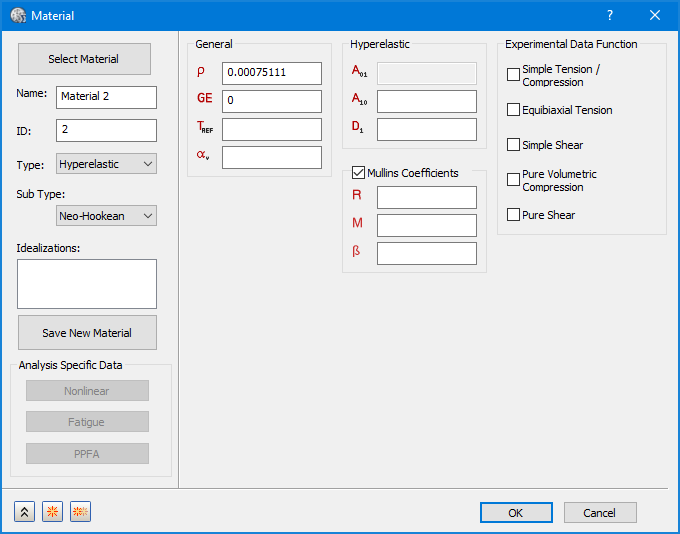
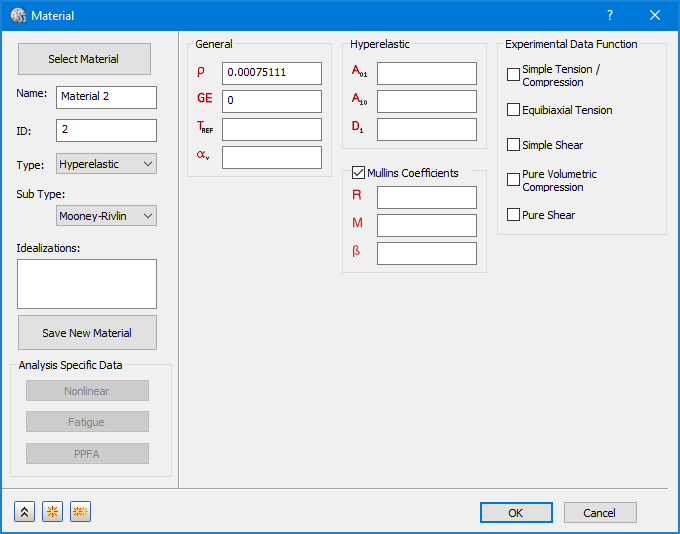
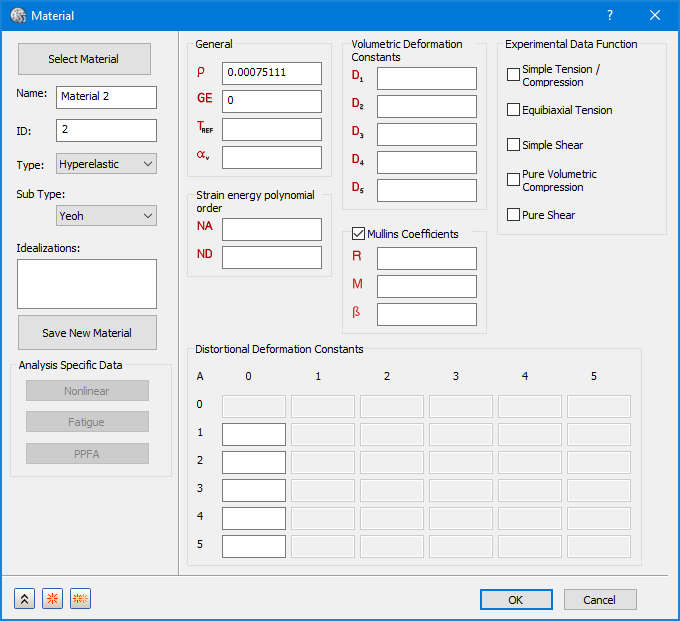
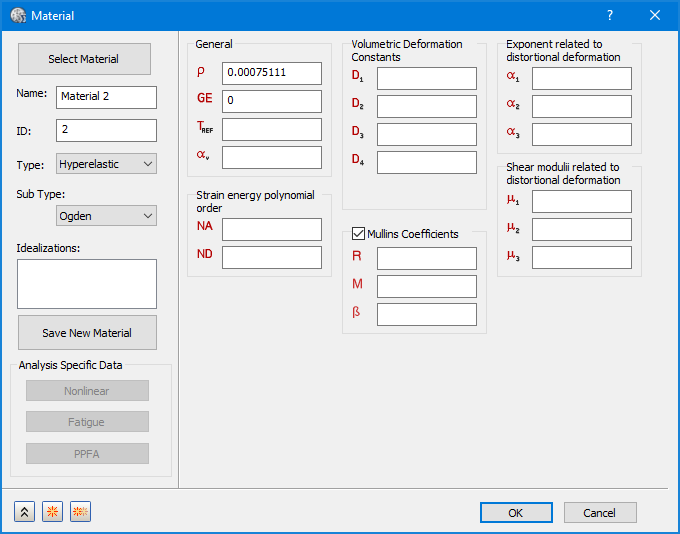

- For Sub Type you can choose from Neo-Hookean, Mooney-Rivlin, Ogden, Yeoh, and Polynomial, as shown in the above images. Each type has a specific set of material constants to define.
- The mass density, RHO, will be used to automatically compute mass for all structural elements.
- To obtain the damping coefficient GE, multiply the critical damping ratio C/C0 by 2.0. If a dominate frequency is not defined for Material Structural Damping (see Dampings section), GE is ignored in transient response analyses.
- TREF is used only as the reference temperature for the calculation of thermal loads in linear solutions. If an initial temperature load is specified, TREF will be ignored.
- You can define the thermal expansion coefficient, mass density, material damping coefficient, and material reference material.
-
Experimental Data Function
- Aij and Di are obtained from least squares fitting of experimental data. One or more of four experiments (simple tension compression, equibiaxial tension, simple shear, pure shear, pure volumetric compression) may be used to obtain Aij. Di may be obtained from pure volumetric compression data (TABD). If all TAB1 through TAB4 are blank, Aij must be specified by the user. Parameter estimation, specified through any of the tables, supersedes the manual input of the parameters.
- If ND = 1 and a nonzero value of D1 is provided or is obtained from experimental data in pure volumetric compression, then the parameter estimation of the material constants Aij takes compressibility into account in the cases of simple tension/compression, equibiaxial tension, and general biaxial deformation. Otherwise, full incompressibility is assumed in estimation of the material constants.
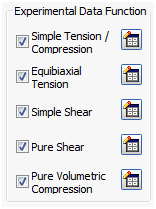
- Table icon
 : Allows you to define an experimental data function obtained from physical tests. You can define tables for
Simple Tension/Compression,
Equibiaxial Tension,
Simple Shear,
Pure Shear, and
Pure Volumetric Compression.
: Allows you to define an experimental data function obtained from physical tests. You can define tables for
Simple Tension/Compression,
Equibiaxial Tension,
Simple Shear,
Pure Shear, and
Pure Volumetric Compression.
- Simple Tension/Compression: Data to be used in the estimation of the material constants Aij. xi values in the table must be stretch ratio
 and yi values must be values of the engineering stress
and yi values must be values of the engineering stress
 . Stresses are negative for compression and positive for tension. If this convention is not followed, the solution may fail to converge.
. Stresses are negative for compression and positive for tension. If this convention is not followed, the solution may fail to converge.
- Equibiaxial Tension: Data to be used in the estimation of the material constants Aij. xi values in the table must be stretch ratio
 . yi values must be values of the engineering stress
. yi values must be values of the engineering stress
 .
.
 is the current length,
F is the current force,
is the current length,
F is the current force,
 is the initial length and
is the initial length and
 is the cross-sectional area. In the case of pressure of a spherical membrane, the engineering stress is given by
is the cross-sectional area. In the case of pressure of a spherical membrane, the engineering stress is given by
 , where
P is the current value of the pressure and
, where
P is the current value of the pressure and
 and
and
 are the initial radius and thickness, respectively.
are the initial radius and thickness, respectively.
- Simple Shear: Data to be used in the estimation of the material constants Aij. xi values in the table must be values of the shear tangent
 and yi values must be values of the engineering stress
and yi values must be values of the engineering stress
 .
.
- Pure Shear: Data to be used in the estimation of the material constants Aij. xi and yi values in the table must be stretch ratio
 and values of the nominal stress
and values of the nominal stress
 .
.
 is the current length,
F is the current force,
is the current length,
F is the current force,
 and
and
 are the initial length and cross-sectional area, respectively, in the 1-direction.
are the initial length and cross-sectional area, respectively, in the 1-direction.
- Pure Volumetric Compression: Data to be used in the estimation of the material constants Di. xi values in the table must be values of the volume ratio
 , where
, where
 is the stretch ratio in all three directions; yi values must be values of the pressure, assumed positive in compression.
is the stretch ratio in all three directions; yi values must be values of the pressure, assumed positive in compression.
- Table icon
- Mullins Coefficient (specific to Explicit Analysis)
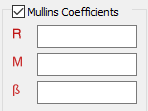
- Specifies the Mullins effect for hyperelastic materials. This checkbox should only be selected when running Explicit analyses.
- R, M, β are Mullins coefficients.